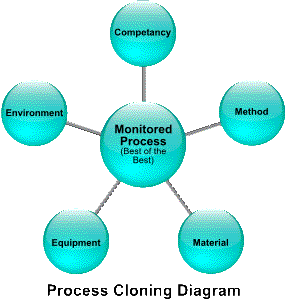Wish you could find a better way to reduce costs and improve processes before it's too late? Here's a new approach!
Ever more, customers require that we focus on continual process improvements. The process is not limited by manufacturing and/or assembly steps, but includes every phase and step, which is involved with taking the order to delivering the product or service, including after delivery activities. Today, more than ever, reducing costs is not just important; it's survival. More and more jobs are lost to those who can do it with added value (cheaper without sacrificing quality, service or delivery). The old cliche about quality being related to fit and function is truly passe. A more appropriate definition for quality today is, "The totality of aspects and features, which lead to customer satisfaction".
With so many choices at hand, most find it difficult to choose the right tools. Many are flocking to Six Sigma. With the advent of Six Sigma methodologies, most customers, suppliers, and sub-contractors have been urged to
"Define, Measure, Analyze, Improve, and Control". All perfectly rationale reaction steps in ferreting out nonconformance issues, problems and non value-added activities. These steps all use old tried and true statistical tools, which are matched and/or chosen to fit the situation.
This article is not a condemnation of Six Sigma methods. It is one attempt to change our focus of when to utilize the methods. Usually, the use of Six Sigma methods is used in a reactive situation. We believe that situational reaction, has its place, but it is of far better value to take the proactive approach.
In most business, there are process steps involving clerical, administrative, technical, application, safety, assembly, manufacturing, transportation, packaging, delivery and servicing related activities. If one were to view every process activity for best practices and develop a plan to clone, or cross-pollinate, those best practices onto other similar activities, great value would be realized.
A method developed by KAVON Action Group is called "Process Cloning". Using Define, Measure, Analyze, Improve and Control, we approach every activity proactively to find and grow best practices.
 DEFINE
DEFINE
The following Process Cloning Diagram maps out a way of starting to dissect the activity.
MEASURE
Every activity that is repeated over time will produce a best practice, whether it is an isolated activity or many activities with similar inputs and outputs. We can all remember some mundane activity that we have observed or performed, which had similar inputs, but resulted in varied outputs. A personal example of mine might be a round of golf. Same course, same clubs, same types of balls, same weather conditions, same clothing, same swing (I think) etc., but varied output results.
Therefore, we need to measure and/or pinpoint the best practice. I can remember in my many years in manufacturing that there were operators who never ever were associated with nonconforming product, and maintained optimum productivity. Of course this was only one aspect of the activity, but certainly an important one. This step of Process Cloning is used to measure inputs and outputs of the activity in a quantitative and qualitative method.
ANALYZE
This step of Process Cloning is closely tied into
MEASURE. It is where we analyze the data, factors, characteristics, conditions, maintenance activities, training, materials, etc. of the activity, using problem-solving techniques, including all those identified inputs that feed the activity (as shown by diagram). This step is used to measure and analyze the inputs and outputs of the identified inputs as well as the activity itself. In this step, opinions are ruled out, and only objective evidence is utilized.
IMPROVE
This step focuses on the actual cloning of best, correct practices found and validated during the
MEASURE and
ANALYZE steps. This is where the cross-pollination takes place into other similar activities and/or into activities that could benefit from improvement techniques. This phase is where a Process Cloning Plan must be generated. This includes, but is not limited to:
- Identifying the scope of the implementation.
- Who is to do what?
- When?
- What resources will be required?
- Who will communicate the plan phases and how?
- Will there be any side effects?
- How long of a validation period?
- What, when, and how many measurements will be taken?
CONTROL
This step must consider the necessary steps to ensure institutionalizing the cloning. This includes, but is not limited to:
- What training and competency is necessary?
- What documents (Control Plans, FMEA's, Manuals, Procedures, Instructions, Flow Charts, etc.) need to be revised?
Finally, the use of this type of methodology ensures that "Doing Right Things Right" is the desired outcome, and we are dealing with fact rather than fiction. The object of this approach is to focus on what's working instead of what's not working, before we reach the "Who is to blame?" stage.
Of course, there are statistical methods of analysis and measurements used; forms and techniques not discussed in this article.
